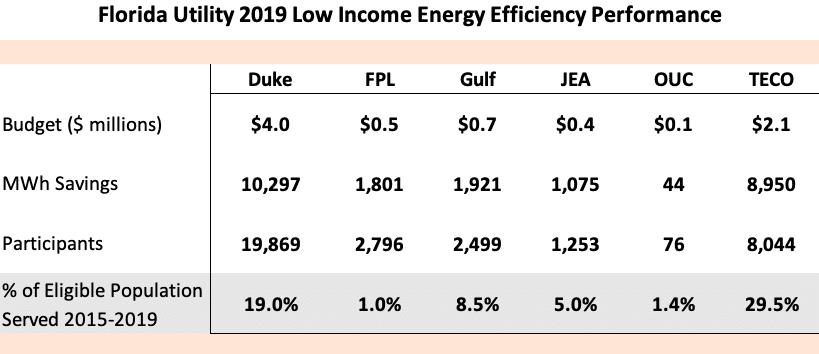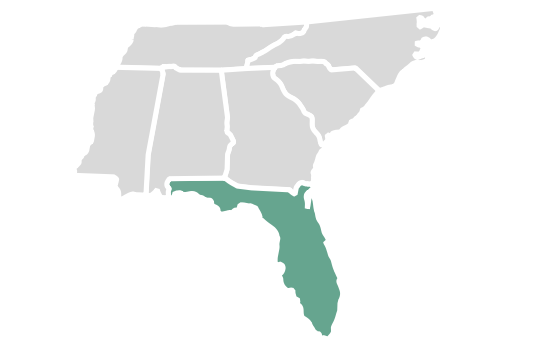Florida Has High Energy Bills and Poor Efficiency Performance
Florida has some of the nation’s highest monthly residential electric bills, but despite this fact, Florida utilities consistently block efforts to increase goals for low-cost energy efficiency programs – the very programs that are essential for reducing energy bills, especially for low-income consumers.
The Southern Alliance for Clean Energy (SACE) tracks energy efficiency policy trends and utility performance every year with our Energy Efficiency in the Southeast Annual Reports; and year after year, Florida’s major utilities trail far behind the national average, in fact, the state consistently ranks among the worst in the region on efficiency performance.

2019 Efficiency Reports Reveal Key Differences Between Utilities
Recent filings at the Florida Public Service Commission (PSC) show these disappointing trends persisted through 2019. But even though they congregate at the bottom, all Florida utilities are not equal.
Florida Power & Light (FPL) and Gulf Power (Gulf) (subsidiaries of the same parent company NextEra) stand out among Florida’s investor-owned utilities for having the lowest energy efficiency performance in 2019, both in absolute terms and relative savings as a percentage of energy sales. By contrast, Tampa Electric Company (TECO) and Duke Energy Florida (DEF) delivered comparatively higher energy savings overall, and both are leaders in the state for delivering energy savings to low-income customers.
Overall Efficiency Performance Rankings
FPL, the state’s largest electric utility, provides electric service to an estimated 10 million people. FPL’s annual sales are nearly three times higher than Duke and six times higher than TECO, but FPL trails far behind both of these smaller utilities in total efficiency savings.

Calculated as a percentage of retail sales, the difference is even starker: in 2019, TECO delivered more than 13 times higher efficiency savings than FPL. While FPL’s performance has been consistently low and uneven from year to year, savings from TECO’s efficiency program have seen rapid growth in recent years, including roughly doubling its total kWh energy savings in 2019 over the previous year.
DEF is roughly one third the size of FPL, but savings over the past four years were four times higher in absolute terms. In 2019, DEF’s performance as a percentage of annual savings was also four times higher. Even this pales in comparison to DEF’s sister company, Duke Energy Carolinas, which is the regional leader for energy efficiency and was the first to reach 1% annual efficiency savings – five times higher than DEF and 20 times higher than FPL.
Mixed Performance Among Florida’s Smaller Utilities
Gulf Power had the worst performance of all major Florida utilities in 2019. As a percentage of annual sales, it was about 10% lower than FPL. by contrast, TECO – just three times larger than Gulf – delivered total savings that were 26 times greater. And TECO’s savings as a percent of annual electricity sales were more than 16 times higher than Gulf’s.
In 2019, the Orlando Utility Commission (OUC), a municipal utility owned and operated by the City of Orlando, saw its efficiency savings plummet by more than half from their performance over each of the previous two years. The only thing holding up their overall savings was commercial lighting and the city’s conversion to LED street lights. This news is particularly troubling considering the fact that in 2017, Orlando officials committed to a transition to 100% renewable energy. Reducing energy waste is key to achieving this goal, and will require much larger investments in energy efficiency by OUC in the coming years.
Jacksonville Electric Authority‘s (JEA) performance is 2nd highest among Florida’s major utilities, but complicated by unusual accounting issues. The utility counts savings from audit programs that the Commission generally disallows, while separately tracking a more robust set of “off-ledger” programs. Since JEA did not seek PSC approval for some of these programs, there is no guarantee they will continue. Without these programs, JEA’s results appear only marginally better than FPL and Gulf. However, when JEA’s off-ledger programs are included, it is actually one of Florida’s better performers.
Energy Efficiency Programs Key for Low-Income Customers
High power bills force impossible choices for working families, retirees, and the millions of Florida households who regularly struggle to pay their monthly energy bills and still afford basic necessities like rent, food, and medicine. This already difficult situation has been severely exacerbated by the economic turmoil caused resulting from the COVID-19 pandemic, plus the lack of efficiency programs for vulnerable frontline communities further exposes the economic disparity of a high energy burden.
Energy efficiency is widely recognized as the best strategy for reducing high energy burdens and was a central focus of SACE’s testimony to the Florida PSC last year. But performance varied considerably between Florida’s major utilities in 2019.

As noted above, TECO not only delivered more total savings than any other Florida utility, its Neighborhood Weatherization low-income efficiency program reached 6,740 customers in 2019 – more than FPL, Gulf, JEA, and OUC combined. Kudos to TECO for serving 28.8% of the eligible low-income population with this program over the five year period since the last FEECA goals were set, more than any other Florida utility.
Like TECO, Duke serves a large number of customers through its low-income focused Neighborhood Energy Saver program, roughly 20,000 in 2019 and each of the previous three years. Since 2015, Duke has reached 19% of eligible customers in its service territory.
While these neighborhood-style programs are laudable for reaching a great many customers, the financial savings they produce for each customer are relatively modest and do not make a substantial impact on family budgets. However, Duke also operates a Low-Income Weatherization Assistance program that delivers deeper savings for customers in need. These savings can be enough to make a substantial financial impact for customers who struggle to keep the lights on and still afford other basic household necessities. While this program was much smaller in scope, reaching only 373 customers in 2019, its deeper savings approach makes it a model that should be scaled up and emulated by the rest of Florida’s major utilities.
FPL and OUC provided by far the least amount of savings to low-income customers, in both absolute and proportionate terms. In recent years, OUC has dramatically reduced savings in its program for low-income customers from a high point serving 588 customers in 2015, down to just 6 customers in 2018. In 2019, the number went up to 76, but that still constitutes only a tiny fraction of eligible customers – far inadequate for the Florida utility serving a customer base with the highest percentage of low-income residents. In 2019, FPL served just 2,796 households. Adjusted for their respective total residential customer counts, Duke and Gulf both delivered more than 20 times the low-income energy savings of FPL and OUC – while TECO delivered nearly 45 times the savings of these low performing utilities.
Looking Ahead to the Next Five Years of Efficiency in Florida
Last year, the Florida PSC once again set efficiency savings targets for each of Florida’s major utilities. If you want to see where things are going next, keep an eye out for our analysis on these utility program plans for 2020-2024. The Commission took up OUC and JEA’s program plans first and will hold a public hearing to review the efficiency plans for FPL, Duke, Gulf, and TECO on July 7.
This blog is Part 5 in the series following the release of the Energy Efficiency in the Southeast 2019 Annual Report. To learn more about the findings of the report:
- Read Part 1 of the series giving an overview of the report: “Energy Efficiency in the Southeast” 2019 Annual Report.
- Read Part 2 of the series showcasing regional leadership by North Carolina and Duke Energy: “North Carolina and Duke Energy Hold Commanding Lead on Energy Efficiency in the Southeast“
- Read Part 3 of this series on the relationship between energy efficiency and integrated resource planning in Mississippi: “Efficiency in Mississippi: Utilities Can Do More, Customers Deserve No Less.“
- Read Part 4 of this series showing how the Southeast stacks up against the rest of the country: “Southeast Utilities Falling Behind: ACEEE Efficiency Scorecard Confirms What SACE Already Knew. Nowhere to Go But Up!“
- Watch a webinar where SACE technical staff discusses report findings.
- Additional blogs related to energy efficiency in the Southeast here.
#EEinSE2019



